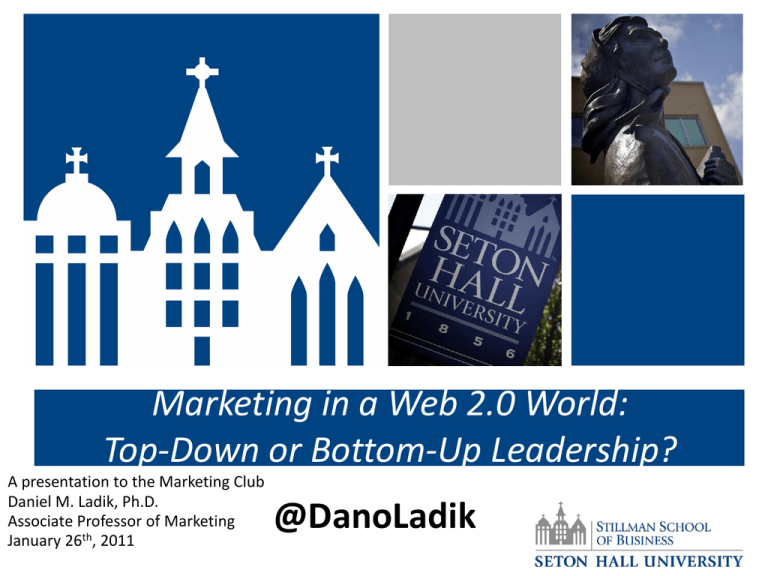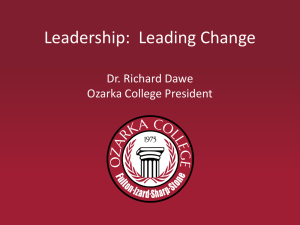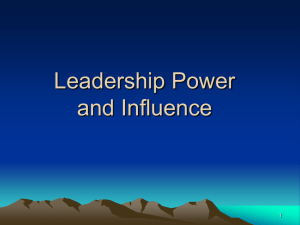Presentation - Dig Nuggetville
advertisement

Marketing in a Web 2.0 World: Top-Down or Bottom-Up Leadership? A presentation to the Marketing Club Daniel M. Ladik, Ph.D. Associate Professor of Marketing January 26th, 2011 @DanoLadik Leadership?!@#$%^&*!? • What IS Leadership? • Can you name a few leaders? 2 A Definition…. • “………….the capacity to establish direction and to influence and align others toward a common aim, motivating and committing them to action, and making them responsible for their performance.” 3 True or False? • Leaders are born………….. 4 FALSE! • Leadership is increasingly recognized as a transferable skill: it can be taught. The “Great Man” theories of leadership that used to predominate have been proven false. – “The Great Man theory of history is usually attributed to the Scottish philosopher Thomas Carlyle, who wrote that ‘the history of the world is but the biography of great men.’ He believed that it is the few, the powerful and the famous who shape our collective destiny as a species. That theory took a serious beating this year.” Time Magazine 1/1/2007 • Leadership is more than command and control (e.g., killing the “old general” metaphor) • New contemporary theories/ideas concerning leadership are emerging 5 Transactional & Transformational Leadership • Two vital strands of leadership – transactional and transformational leadership. – Transactional leadership is built on reciprocity – the relationship between the leader and their followers develops from the exchange of some reward such as performance rating, pay, recognition, and praise (Theory X). – A transformative leadership style is described as one that motivates through identification with the leader’s vision, pulling rather than pushing others on (Theory Y). • Transformational leadership occurs when one or more persons engages with others in such a way that leaders and followers raise one another to higher levels of motivation and morality. – Greenleaf’s (1997) image of a leader as servant – Block (1993) stewardship • The secret of effective leadership appears to lie in combining the two elements so that targets, results, and procedures are developed and shared. 6 Geeks & Geezers • As a result of their research for this book, Bennis and Thomas have developed a theory/model of leadership development – Real experience under fire – Critical learning and experiential learning – Leaders create a shared meaning: A common goal – everyone is one the same page • Stripped to its essentials, leadership involves just three things – a leader, followers, and a common goal. • They found that every leader in they study, young or old had undergone at least one intense, transformational experience - - this experience was at the very heart of becoming a leader. – Crucible “a place, time or situation characterized by the confluence of powerful intellectual, social, economic or political forces; a severe test of patience or belief. 7 Goldman “Leadership That Gets Results” • On the basis of findings from 3781 executive participants, the research suggests that leaders gain the best results by using a combination of six leadership styles, each of which has a central characteristic feature and uses different components of emotional intelligence…. 8 Goldman “Leadership That Gets Results” Description Leader’s Modus Operandi Coercive Pacesetting Demand instant obedience. Coercive leaders are self-motivated, initiate change, and are driven to succeed Set high standards of performance. Pacesetting leaders use their initiative, and are selfmotivated and driven to succeed Demands immediate compliance Sets high standards for performance “Do as I do now.” The style in “Do what I tell you.” a phrase Authoritative Democratic Coaching Build relationships. Affliliative leaders are empathetic and have good communication skills Actively encourage team involvement in decision making. Good at communicati on, listening, and negotiation Expand and develop people’s skills. Have the ability to listen well, communicate effectively, and motivate others Mobilizes people toward a vision Creates harmony & builds emotional bonds Forges consensus through participation Develops people for the future “Come with me.” “People come first” “What do you think?” “Try this.” Energizes people toward a common goal. Authoritative leaders initiate change and are empathetic 9 Affilliative Leadership summary…… ●Servant Leader ●Transformational ●Coach ●Transactional ●General Theory X (Coercive -0.26) Theory Y (-- Pacesetting -0.25) (-- Authoritative (0.54) Affilliative (0.46) Democratic Coaching (0.42) (0.43) (Overall impact on corporate climate) 10 Leadership Nuggets • Three words leaders have trouble dealing with: “I don’t know.” I think good leadership will often start with questions whose answer is: “I don’t know, but we’re going to find out.” (Warren Bennis) • None of us is as smart as all of us. (Warren Bennis) • It will require the creation of what I regard as the “virtuous teaching cycle,” which implies that “I teach you, but I create the situation where I learn from you, as well.” Leaders will need to become better listeners and not just communicators. (Noel M. Tichy) 13 In a Web 2.0 World, why should marketers care about leadership? Yes, everyone needs good leaders, however…. • With a CRM culture, marketers are rising to the CEO post in ever increasing numbers – 1970s & 1980s vs. 1990s & 2000s • Marketers should drive organizational change – “Marketers have to be the leaders of change. There is no other department that has a better understanding of customers and drives that understanding throughout the organization” Peter Kim, Senior Analyst at Forrester Research 12 A New Era? – The Web 2.0 World • The days of “we package it and your buy it” are gone… • The consumer and the firm are intimately involved in jointly creating value that is unique to the individual consumer and sustainable to the firm. • Traditional exchanges are transactional – One way: Firm to consumer (e.g., B-to-C) • Modern exchanges are relational (e.g., CRM) – Multi-way: B-to-C, C-to-B, & C-to-C • Customers become advocates 14 Marketing needs leadership ideas NOW! • Consumer or Community Generated Marketing – Web 2.0 – Organized around people – based on relationships – Ebay, Facebook, YouTube, Twitter, Wikipedia, Linux, Craigslist, LinkedIn, Flickr, Google, Blogger, Amazon, Netflix, Threadless – Community and Collaboration – WWW as a tool for bringing together the small contributions of millions and making them matter (The Wisdom of Crowds) – Engaging, interactive, authentic – “It’s the User-Generated Generation” Brian Williams • Branding – Harley Davidson – Authenticity: actual customer experiences that personally engage the customer 15 The Emerging Concept of a Market Firm-Customer Interaction (1) Interaction is the locus of co-creating of value and economic value (2) Co-Creation Experiences are the basis of value The Firm: Collaborator in co-creating value and competitor in extracting economic value The Market: Co-creation Experiences of Unique Value The Customer: Collaborator in co-creating value and competitor in extracting economic value Prahalad and Ramaswamy (2004) The Future of Competition: Co-Creating Unique Value with Customers 16 Final thought from Professor Randy Pausch • Randy was asked, “Because our past is tied so intricately to our future, do you feel that one’s worth or even legacy includes all the regrets – brick walls succumbed to – or does it matter at all in the scheme of things in this universe or this life?” • Randy responded: “Absolutely, our legacy includes all the brick walls – the ones we got over and the ones we didn’t, right? I didn’t get into the NFL and I talked about that in the lecture, as you know. But again, at Electronic Arts, I learned this wonderful expression – experience is what we get, when we don’t get what we wanted – and of course part of our legacy is all the things we failed at because failure is where most of the learning occurs. So I like to tell my students, you know if you are failing a lot, you are probably learning more per time-unit then most of your peers, so don’t get discouraged.” 17 Reading List • Geeks & Geezers: How Era, Values, and Defining Moments Shape Leaders – Warren G. Bennis & Robert J. Thomas • Emotional Intelligence or Primal Leadership or Social Intelligence – Daniel Goldman • The Future of Competition: Co-Creating Unique Value with Customers – C.K. Prahalad & Venkat Ramaswamy • The Perfect Store: Inside eBay – Adam Cohen • How Brands Become Icons: The Principles of Cultural Branding – Douglas Holt • Outliers or Blink – Malcolm Gladwell • The Wisdom of Crowds – James Surowiecki 18




